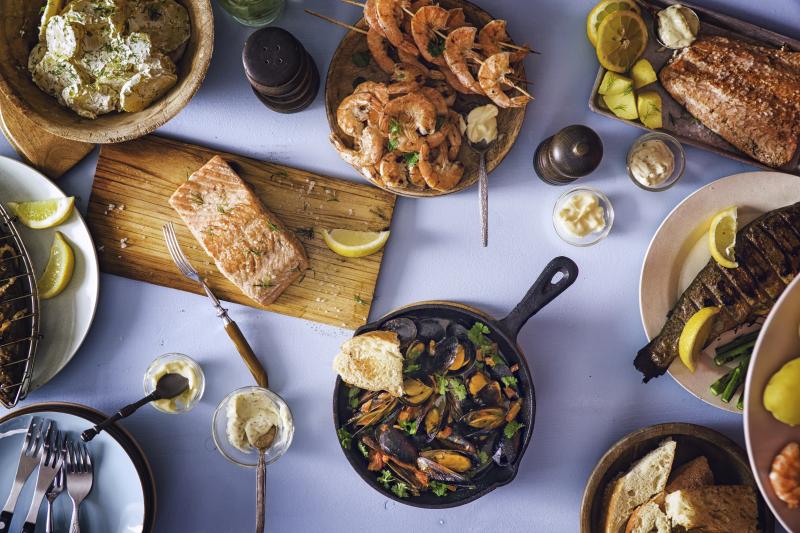Seafood Month is the perfect time to let a new fish dish win over your taste buds. Seafood is a healthy, nutrient-dense source of protein. Some fish are also high in omega-3 fatty acids, which are good for your heart and can reduce the risk of heart disease and stroke. The American Heart Association recommends eating 2 servings of fish (particularly fatty fish) per week.
Need help finding your new sole mate? Take a family adventure to a fish market, or simply try a new product from your regular grocery store. Prefer to stay in? Seafood sellers have increased their online presence in recent years, allowing you to ship new variety to your doorstep. We’ve compiled a few suggestions, but you’ll find there are plenty of fish in the sea.
Summer Flounder: Not Just a Fluke
Wanting to try something new but not sure where to start? Find yourself … floundering? Good choice! There are many species of flatfish that are at least occasionally called “flounder,” but summer flounder (also known as “fluke”) is among the most popular.
Summer flounder get their name from their summertime migration to Atlantic nearshore waters, where they were easier to catch. Today, they are fished commercially year-round from Maine to North Carolina and are available whole or filleted, fresh or frozen.
With a mild taste and fine flake, summer flounder fillets adapt easily to your choice of preparations and seasonings. A crowd-pleasing place to start might be fried flounder. Pan-frying marinated fillets achieves a flavorful crisp with less oil and fewer calories than deep-frying. For a more heart-conscious preparation, try steaming the flounder and topping with a spicy ginger and soy sauce.
Wholly Mackerel
Feeling bolder? Branch out a little further with a fish that you’ve probably heard of, but may not have tasted: mackerel! Salted, and later canned, mackerel were once staples of American diets. Today they are more familiar to recreational anglers as prized tournament sportfish (king mackerel) or popular baitfish (Spanish mackerel). But this “old” seafood star is a healthy and sustainable “new” fish to try this year. Fast-growing, fast-swimming cousins of tunas, mackerels are a great source of omega-3 fatty acids that support your heart, brain, and immune system.
Compared to milder tasting flounder, mackerel has a richer, more pronounced flavor. This can be reduced by removing the outer bands of dark meat around the fillets’ midline. For an easy and healthy preparation of fresh mackerel fillets or steaks, broil the mackerel with a mixture of parsley, tarragon, and thyme. Or coat mackerel fillets with a maple-pecan crust, bake, and serve with cayenne yogurt sauce for a sweet and savory flavor contrast.
Magnum Opah
A fish you’re less likely to have heard of is opah, sometimes called moonfish. Round and red-finned, the six species of opah are solitary fish that swim in the open ocean. They are caught only incidentally by fishermen targeting bigeye tuna in Hawaii or swordfish off of California. While incidentally they were discarded or given away as gifts, in recent years they’ve gained popularity among seafood eaters. NOAA Fisheries has partnered with industry to find new ways to use opah and reduce waste in processing.
Several years ago, NOAA Fisheries scientists discovered opahs to be the first known fully warm-blooded fish (that is, they circulate heated blood throughout their bodies.) This unique circulatory system creates seven distinct types of opah meat, each with different flavor and texture.
Generally, opahs have a rich, creamy taste, between that of tuna and swordfish, and a firm texture with a large flake. Like tuna and swordfish, opah steaks are great for grilling. To pair a familiar taste with a new fish, try opah chili, which uses ground opah abductor/adductor muscle (often sold as “opah flank”).
Flex Some Mussels
Maybe you’ve tried a few new fish lately and you’re ready to come out of your shell. If you’ve never cooked shellfish before, mussels are a great place to start—they’re affordable and quick to prepare.
Blue mussels are farmed on both U.S. coasts, grown either in tidal mussel beds or on ropes attached to floating platforms. Mussel farms provide environmental benefits, because the filter-feeding mussels remove excess nutrients from the water column and improve water quality.
When buying mussels, check to make sure the shells are unbroken and stay closed, indicating that they are still alive. Store them in the refrigerator covered in wet paper towels to keep them moist until ready to use. Steam mussels in liquid for 5-7 minutes, until they pop open.
Blue mussels’ tender yellow meat have a sweet flavor that you can pair with a wide array of ingredients. For a classic preparation, try steaming mussels in garlic broth. Venture to a tropical cuisine by steaming them in coconut milk with lemongrass and ginger. Entertaining? Steam mussels and serve them on the half shell topped with buttery broiled bread crumbs for an enticing appetizer.
- Mussels in Garlic Broth
- Steamed Mussels with Coconut Milk, Ginger, Lemongrass, and Green Beans
- Broiled Mussels with Garlic Herb Bread Crumbs
A Little Kelp from Our Friends
Finally, branch out farther this year by expanding your seafood palate to include a sea vegetable—like kelp. Unlike most seafood, you can share it with your vegetarian or vegan friends! Kelp and other seaweed and algae are great sources of vitamins, minerals, and antioxidants.
In the United States, sugar kelp is sustainably farmed in Alaska and in cold water regions along the east and west coasts. It’s available fresh during its harvest season, which is February through May, and it’s available dried year-round. This species gets its name from the sweet powder that forms on its blade when dried.
Watch: video on kelp farming in Alaska
Sugar kelp can work well as a substitution for kombu or konbu in Japanese cuisine. You may be familiar with kombu as the flavoring of the broth in miso soup. If you have fresh sugar kelp, try combining the cooked kelp with dressed cucumbers and blueberries for a refreshing salad.
Eating Variety Helps Us Eat Sustainably
When you try new seafood, whether at a restaurant or in your own kitchen, you embark on a culinary adventure. But you’re also making someone else’s adventure possible. Eating a variety of wild-caught fish supports fishermen who brave the waves throughout the year in search of different species in different seasons. Buying farmed shellfish or kelp supports growers who are pioneering sustainable ways to extract nutrition from the ocean. When you purchase U.S.-caught and U.S.-grown seafood, you know that it is responsibly managed and informed by the latest science.
Find more recipes for the U.S. seafood you love on FishWatch. Want to learn more about seafood but don’t know where to start? FishWatch also arms you with the facts about what makes U.S. seafood sustainable—from the ocean or farm to your plate. Get up-to-date information on the status of harvested marine fish and farmed fish, and learn more about U.S. seafood.







